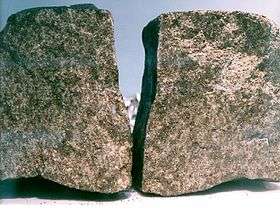
Nakhla meteorite
Nakhla is a martian meteorite fallen in Egypt in 1911. It was the first meteorite reported from Egypt, the first one to suggest signs of aqueous processes on Mars, and the prototype for Nakhlite type of meteorites.
History
It fell on Earth on June 28, 1911, at approximately 09:00, in the Abu Hommos district, Alexandria Governorate, Egypt (now Abu Hummus, Beheira Governorate), in the area of the village of El Nakhla El Bahariya. The stones were collected near hamlets of Ezbet Abdalla Zeid, Ezbet Abdel Malek, Ezbet el Askar, and Ezbet Saber Mahdi. Many people witnessed the meteorite approaching from north-west, inclination about 30°, along the track marked with a column of white smoke. Several explosions were heard before it fell to Earth in an area of 4.5 kilometres (2.8 mi) in diameter, and about forty pieces were recovered; the fragments were buried in the ground up to a meter deep. From an estimated original weight of 10 kilograms (22 lb), recovered fragments ranged in weight from 20 g to 1813 g.
Podcasts:

